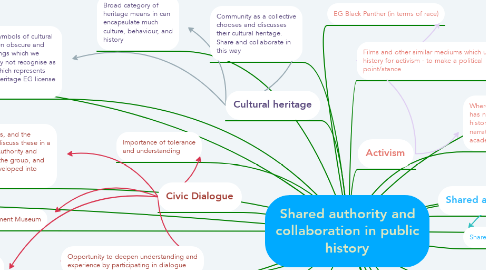Shared authority and collaboration in public history
by Rebecca Jodie Illidge

1. EG Black Panther (in terms of race)
2. Community as a collective chooses and discusses their cultural heritage. Share and collaborate in this way
3. Broad category of heritage means in can encapsulate much culture, behaviour, and history
4. Such objects symbolise cultural identity, locating people in a moral order and class hierarchy (Frank E. Manning)
5. Objects as symbols of cultural heritage. Even obscure and mundane things which we ordinarily may not recognise as something which represents culture and heritage EG license plates
6. Importance of tolerance and understanding
7. Museums as places of civic engagement
8. Allows a variety of opinions, and the opportunity to share and discuss these in a safe group environment. Authority and inquiry is shared between the group, and often times this can be developed into something more
9. Comfortable setting EG kitchen conversations - participants feel more at home and engage more, giving their honest opinions
10. Use of an objective facilitator
11. For example: the Tenement Museum
12. Opportunity to deepen understanding and experience by participating in dialogue
13. Cultural heritage
14. 1. Audience i.e not academics
15. The concept of shared historical authority envisions that institutions increasingly invite non-professionals to share their viewpoints and experiences. It usually applies to those whose past is being told, and who don't usually have a platform on which to share their stories. Shared authority and collaboration arguably removes the hierarchy that is present within most institutions, where one dominant narrative is presented - usually from a colonist point of view, where minorities are not afforded a say. For example, the University of Michigan's Exhibit Museum of Natural History displayed dioramas of Native Americans among animal exhibitions, arguably placing them on a similar level. The point of view of those depicted was obviously not considered, and these same people took action to get them removed. Collaboration and shared authority looks like museums such as the American Indian Cultural Center and Museum, who works alongside the Indigenous Peoples Museum Network to ensure the correct representation of indigenous peoples in their museum
16. Collaboration, or shared authority, is one of the three major concepts within Public History
17. Civic Dialogue
18. j
19. Where collaboration and shared authority has not happened. Attempt to rectify historical anomalies and reinsert hidden narratives into mainstream history and academia
20. Films and other similar mediums which use history for activism - to make a political point/stance
21. The research (inquiry) into the topic/era is completed by more than just the historian
22. Give and take research provess
23. The historians’ queries triggered memories. In turn, the interviewees’ recollections suggested new questions, and those elicited still more. Both interviewer and interviewees contributed to the evolving, shared inquiry
24. Interviews
25. Key component of reflective public history practice; a special commitment to collaborate, respond, and share both inquiry and authority.
26. Shared inquiry
27. Activism
28. 2. Collaboration: it is important to consult those groups whose history is being represented
29. 3. Reflective practices. This can also link to collaboration/shared authority because museums/governments/organisations etc need to reflect upon their practices and outputs to make sure that it reflects the perspectives of many, especially those whose history is being represented and give them a voice
30. Shared authority


